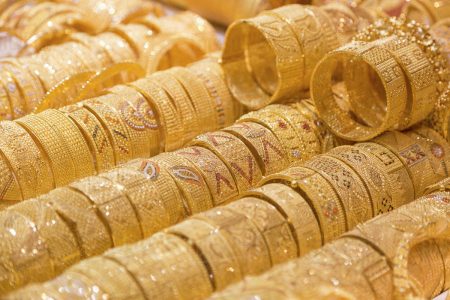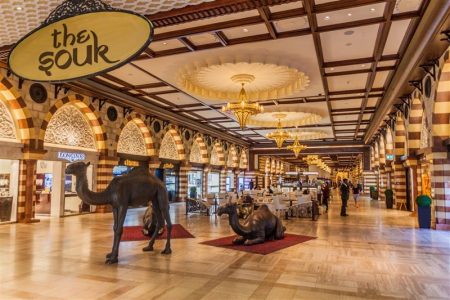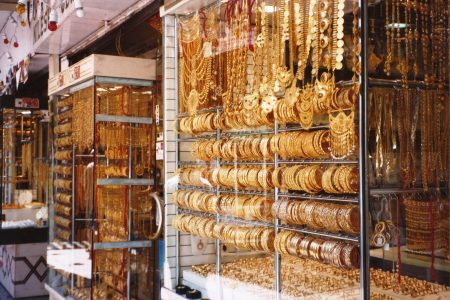The UAE’s shining heritage tells a precious tale
Gold holds great sentimental value to the Emiratis, as the precious metal has alchemized into a symbol of heritage, history and trade exchange change between cultures. This could be one of the major reasons for the existence of such an expansive market solely for the trade of this precious yellow metal.
It is situated in the Deira region in between Dubai Fish and Corniche, which can be easily reached by any tourist or visitor to this global city. Gold is more than just a great selling point of the Emirates, as along with diamonds, but more importantly, it’s a beloved tradition in the Middle East.
 This traditional gold market in Dubai is the largest of its kind in the whole world. With its narrow labyrinthine alleyways, carved wooden roofs and waterfalls of glittering gold jewelry displayed in hundreds of shop windows, the Dubai Gold Souk hearkens back to the early 1900s, when it was founded. There were only a few sellers of gold during its initial phases. At that time, encouraged by a tax-free and trade-friendly environment, a handful of merchants set up shop in an area of Dubai, not far from the creek.
This traditional gold market in Dubai is the largest of its kind in the whole world. With its narrow labyrinthine alleyways, carved wooden roofs and waterfalls of glittering gold jewelry displayed in hundreds of shop windows, the Dubai Gold Souk hearkens back to the early 1900s, when it was founded. There were only a few sellers of gold during its initial phases. At that time, encouraged by a tax-free and trade-friendly environment, a handful of merchants set up shop in an area of Dubai, not far from the creek.
This creek and harbor on the Arabian Gulf facilitated the trade that supported the import and export of gold, as well as the merchants who came to buy and sell it. It grew considerably in the 1940s when new trade policies encouraged Iranian and Indian entrepreneurs to set up shops, but it was the oil boom of the 1970s that made the Dubai Gold Souk the icon it is today. Since then, the market has flourished, and now, more than 400 retail and wholesale shops operate in this bustling district.
IN THE UAE, THE PRECIOUS METAL HAS HAS ALCHEMIZED INTO A SYMBOL OF HERITAGE, HISTORY, AND TRADE EXCHANGE BETWEEN CULTURES
For years, purchasing jewelry from the gold souks in Dubai has meant assured purity, besides quality workmanship and variety in design. At present, besides the large collection of gold, the major other precious metals sold in the market are platinum, white gold and diamonds. The variety and range of designs of jewelry range from the old and conservative to sleek and modern. Different gold hues are also on offer: yellow, white, purple and even pink. Many of these traditional gold merchants can also create custom-made items. It might be to your surprise, but gold can be purchased at much lower prices on the market if bargained well with the sellers! Tight competition among dealers has paved the way for such a situation in the market.

The Gold Souk manages around 10 tons of gold every day. What is even more spectacular is that once roaming around these streets, visitors would suddenly rush into a huge glass case which stores the world’s largest ring that holds the Guinness World Record. This classy spectacle is called Star of Tia- bac. The expensive ring was sculpted by Taiba Gold and Saudi Arabia Jewelry and weighs around 64kg adorned with charming 615 Swarovski stones.
GOLD CAN BE PURCHASED AT RATES DIFFICULT TO FIND ELSEWHERE IN THE WORLD
Talking about luxurious tradition, the 5.1 kg of the weight of this heaviest ever ring is composed of precious stones alone, valued at around $3 million! The ring cost $547,000 to make back in 2000 when gold was priced at about $250 an ounce. Gold prices have since soared and are now trading at about $1,497. The piece is owned by Dubai-based Taiba, and is displayed at the Gold Souk in Dubai as well as the Sharjah Watch & Jewellery Middle East Show.

The magnificent sights that one can see in Gold Souk are indeed unique, reflecting one of the Emirates’ oldest traditions. The patterns that you get to behold from these gold shops are unique to the Arab world. Whether it is the headgear kind of large necklaces, earrings, rings, bracelets, or bangles, all of these accessories are sculpted in most traditional Middle Eastern patterns.
by Mina Vučič